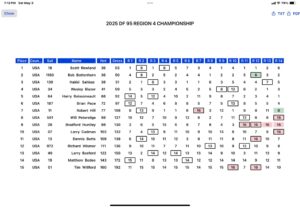The DFICA maintains a tight control on our Restricted Class Rules for compliance at major regattas – Travellers Trophy, State, Regional, National and Global levels.
Author: Martin Bowers
2025 Region 8 Championships hosted by San Diego Argonauts

Photo: J. Golison
2025 Dragonflite95 Region 8 Championship Regatta Report
By: Chris Staiger
The San Diego Argonauts hosted the AMYA 2025 Dragonflite95 Region 8 Championship Regatta May 17th-18th. 21 Skippers from 4 different states including 2 past DF95 National Champions competed.
Friday afternoon began with check-in and practice-racing. Technical Committee Chairman Steve Ross and PRO Chris Staiger performed check-in and measurement and distributed logo hats, while Commodore Pat Nevitt took customized sandwich pre-orders for Sunday’s lunch. (Special thanks also to Pat for his tireless efforts in having the city dredge the reef and make our ENTIRE pond useable once more!)
Saturday morning saw the remaining skippers and boats checked-in under drizzly cold conditions (improved somewhat by hot coffee and donuts provided by Purser Gil Jansky.)
PRO Chris Staiger set 6 marks: an inside leeward Gate, a Start/Finish Line, and two windward marks. The standard long course, which was used for every race in the regatta, consisted of: Start, two windward marks, inside leeward Gate, two windward marks, inside leeward Gate, Finish. Depending on the winds, the windward marks were rounded either to Port or Starboard. The HMS with 2 Fleets and 4-Boat Promotion/Relegation was utilized, resulting in 12/13 Boat Heats throughout the event. Finishes and Scoring were recorded by Steve Delva.
Following the Skippers Meeting, competitors were faced with shifty south to south-westerly winds which required constant relocation of the windward marks and shifting of the Start/Finish Line. Even so, most races on Saturday consisted of long port tacks up the pond with only occasional short starboard hitches. Saturday’s successful skippers managed to dodge the biggest holes and take advantage of the fingery puffs to keep their sails full and their boats moving.
Skippers were treated to Bob Williams’ famous grilled hotdogs for lunch. Bob also provided beverages and ice throughout the weekend.
By the end of the day with 8 races completed, past Champion Mark Golison, led with 11 points, followed by Gary Boell (15), Chris Davidson (17), Jim Sears (20), Kerim Baran (24), with Jon and Dennis Rogers rounding out the Top 7.
Following the racing, skippers were treated to a pond-side Café-Med style barbecue prepared by Chris and Pam Staiger. Opa!
Sunday morning began with more promising conditions: Coffee, donuts, warmer temperatures and 5 – 8 knot winds a bit more westerly than the day before. Marks were adjusted and after a few heats, the breezes filled in and trended more westerly allowing starboard roundings at the windward end to resume. Jan Nevitt provided custom-ordered sandwiches for lunch as the sailing conditions improved. The sun emerged and racing was completed in classic San Diego conditions: 8 – 10 knots of wind straight down the pond under sunny skies and warm temperatures.
By the time the dust settled, Mark Golison had held solidly onto 1st, while Jim Sears leapfrogged into 2nd and Chris Davidson fought past Gary Boell to take 3rd by a mere tenth of a point. The Rogers Brothers (who have a habit of finishing adjacent to each other) took 5th (Jon) and 6th (Dennis).
Skippers were given secret ballots to vote for the one competitor who best exemplified sportsmanship both on and off the racecourse: They chose Jon Rogers to receive the Corinthian Spirit Award.
Thanks to Chairman Gil Jansky, Bob Williams, Jack, and Keith Sturgess who handled site setup and takedown and Tom Warren who manned the rescue boat. Special Thanks to all the Argonauts who worked so hard clearing weeds, algae and debris to restore full use of our Pond!

Photo: J. Golison
R8 RCR Results
A Skippers Report by Len Bose:
Region 8 Championships hosted by San Diego Argonauts started out with a cold breeze out of the south, which made it rather challenging for the PRO Chris Staiger and his team to set up a square race course with the breeze out of the south running athwart the model pond in Mission Bay.
This did not slow down Team Staiger with a plan for every condition. Racing started around 11:15 with eight heats completed under the Heat Management System (HMS). I sailed in 10 races bouncing from B to A, then back to B again, add that with Hot Dogs for lunch and a scrumptious BBQ to wrap up the day. Not to forget one of my favorite parts of traveling regattas, sitting around in our lawn chairs and sharing adult beverages, reviewing the days and the challenges to come.
Looking at the score sheet, the usual suspects are at the top of the score sheet. What is rather encouraging to me are the one or two names that sailed very well during the day and are hanging out with the big dogs. So it can be done, I just need to connect the dots and finish in front of Dan Shier, and I will be that much closer to hanging with the Big Dogs.
You might have noticed that more than one of the big names had to withdraw from the race. Keith Ives had recently completed an eye procedure and is recovering, We hope to be rubbing shoulders with you soon. Chris Raab is looking like a lost dog sitting outside in the cold rain by himself without his good friend Ives around. Feeling bad for the “Little guy,” I called Raab up at around 7:00 pm, asking if he needed a wing man to head over to the San Diego Yacht Club. “Dude, the bed just reached out and grabbed me. I’m done.” Was his reply. Mr. Texas, Brig. North had entered and was unable to attend. North always adds an additional flair to any venue, especially in post race review. Jim Sears went the extra mile, thinking that North would be attending found and purchased a couple twelvies of “Shiner” Texas beer. “There is nothing finer than Shiner!” North, you missed out; that is good beer.
Forecast for Sunday is a cool 65 degrees and 7-9 knots of breeze out of the southwest, I’m off to the pond.
Day two started out much warmer with the breeze still lingering out of the south. PRO “Grand Master” Chris Staiger was conducting his four-dimensional chess board with the variables of wind direction, wind strength, mark set, HMS scoring, and enough Ice in the water cooler. With the breeze out of the south, the fleet was rounding the weather mark to starboard, which is the furthest from shore, while rounding one is on port tack, which led to some excitement with the starboard lay line coming in at the mark. This situation possibly led to the quote of the day: a port tack competitor picked up a gust and broadsided me while I was on starboard. My response was the proper protest hail with the added comments “ With such great velocity and impact, that’s two three sixties .” The infliction of my voice had Gary Boell, who was not in the same heat, said “ You made me wonder if that was in the rules?”
With the marine layer diminishing and the wind shifting to the west, the course was adjusted again, and the fleet returned to rounding the weather mark to port. The battle for the top seven places was extremely competitive, with Mark Golison finishing in the top three twelve times out of the eighteen races. Jim Sears and Chris Davidson were both finding ways to finish in the top half of the fleet throughout the day.
Gary Boell was attacked by a port tack, downwind, boat as he was starting the second beat and was taken out of the race and granted redress. Boell is a closer, and it looked to me he would have finished in a better place than his redress score and missed out on fourth place by one-tenth of a point. We all understand there is a bit of luck while racing RC boats. In the previous event, I took out two people over the weekend, and one of those two was my best friend. This week I was halfway through the second beat in A fleet working towards a finish that would keep me in A fleet, and was taken out by someone who was taking their penalty turn “Shit Happens”.
As always, I enjoyed every moment and hung out with Chris Raab. After Saturday’s racing, I described Raab standing out in the rain. Well, the sun came out on Sunday, and Raab shook himself off and scratched the back of his right ear with his left leg, still not sure how he did that. He was able to stay in A fleet for most of the day, jumping from 18th place on Saturday to 12th after Sunday’s racing.
Dan Shier continued his dominance over me, I did not do myself any favors by missing a race. I had a senior moment after demoting out of A fleet, I went a sat down for the start of the B fleet race. I had better remember that lesson.
Shier’s videos are getting better each event. I received two calls today while writing this, telling me how much they enjoy his efforts. There was another maneuver that I was envious of, Golison. At the trophy presentation, he hailed protest to his lab “Maggie”. She quickly completed a 360. OK, I am done staring at the results page, wondering what if. Now, I just have to figure out how Raab scratched his right ear with his left leg.

Photo: J. Golison
Lets go sailing!
Len Bose
Videos:
DF 95 Region 7 Ranking Event – Hobe Sound FL

Hobe Sound Radio Sailing Hosted the Travelers Trophy DF-95 Ranking Regatta on May 10 and 11, 2025.
24 sailors participated in a one fleet event. Winds were fresh bordering on A and B rigs from South East to South- South East which provided fantastic sailing from the western shoreline of the lake. Half speed tacks and pinching at the top mark turned into going into irons and giving up places. Sixteen races were completed on Saturday with the top 5 coming in as:
1. Landeau, 43 pts.,
2. Bremer 49.5 pts.,
3. Gonsolves 52,pts,
4. Taylor, 68 pts. and
5. Bentz 79.5 pts.
A group went out to dinner at Harry and the Natives and had a great time. The food was great.
The forecast delivered the same conditions on Sunday, but with a bit more breeze than Saturday. Winds ranged from 8 knots to 18 knots with white caps and a nice chop. 31 races were sailed for this regatta. Scores remained close and leads changed on the beats, BUT Tony Gonsolves romped all day with very consistent sailing and 9 first place finishes out of 15 races and his highest scores were 3 thirds the remaining were all seconds- WOW. Baron Bremer also sailed extremely well to capture second. Mr. Steve Landeau finished third after acknowledging a few fouls and doing his turns without being protested. Thanks Steve for setting the example! Chuck Millican also sailed extremely well and moved from 7th on day one to a podium finish of fourth! John Taylor held on to 5th place, sailing well even though he was struggling to stay cool and hydrated.
Congratulations to all who sailed and THANK YOU ALL for sailing and your assistance with the event.
Thanks to the Hobe Sound Farmers Market and Be A Man Buy Land for allowing us to sail and to Captain Crusty for help with scoring and finishes. A hug with love to Karen Luscomb for scoring and organizing and really just keeping everyone on task. ![]() .
.
We hope everyone had fun and we will see you next time.
Report by
Jon Luscomb
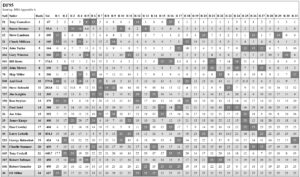
A Competing Skippers Report:
The weekend saw a large fleet arrive at Hobe Sound, for a regatta which is the equivalent of the UK (TT Ranking Series). Two days of racing in hot temperatures of 88*F.
During Day 1, the wind would slowly increase from a mid-range breeze to the top end of A-rig. The race team decided to use a one fleet system and with 24 boats on the start line, it was important to find enough space to start the race well.
During the course of the day Steve Landeau, Baron Bremer and Tony Gonsalves started the regatta with some consistency and by the end of the day and after 17 races those skippers would occupy the top 3 places.
As for me, I also made a good start but I was suffering with the heat and would gulp down water after each race. However, I felt the boat was going well and I was pleased with my start.
On Day 2, the wind had increased with the fleet choosing to use B-rigs. Personally, I thought these conditions would favor me better using my experience from the UK. During the morning session, all seemed well but as we approached the lunch break, that gave me the opportunity to swallow much needed water.
In the afternoon, the wind would drop slightly and become more variable in direction. My performance soon became inconsistent as I was feeling like I was racing my boat in ‘syrup’. At this stage, I just wanted to finish the regatta and keep whatever place on the leaderboard. By this time, I was feeling very hot and bothered, each race more was just an invite for me to free fall down the leaderboard.
In the end, congratulations goes to Tony Gonsalves who put in a very strong second days performance to win. 2nd Place – Baron Bremer and 3rd Place – Steve Landeau. My thanks goes to Jon Luscomb and his race team for all their hard work in running this fantastic regatta.

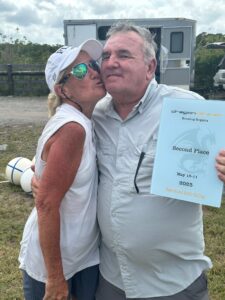
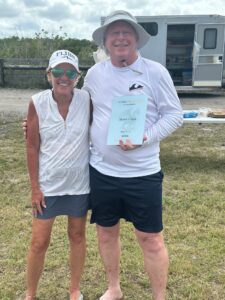
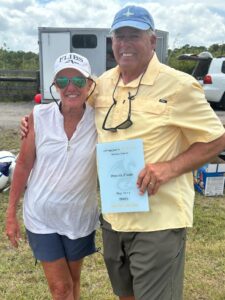
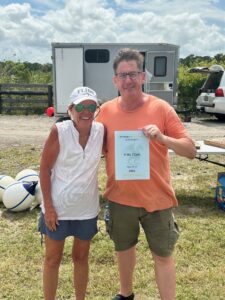
I am very appreciative to Jon and to other skippers who kept checking on me, making sure I was drinking plenty. On reflection, I am really grateful for 5th place after a really difficult week for my boat.
Written by: John Taylor
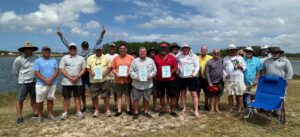
2025 R4 RCR Report – Sandusky OH
2025 Region 8 Travel Trophy – Co-Hosted by the Elk Grove Model YC and the Sacramento Model YC
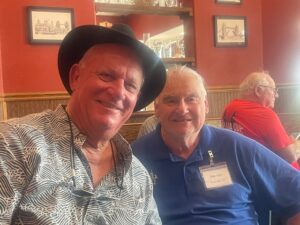
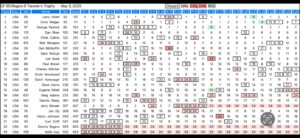
2025 Region 3 – 2nd Annual NC State DF95 Regatta Report

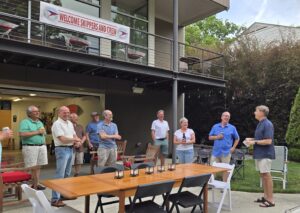
When you have a home port, you feel a certain ease of arrival when you return, but Saturday morning it felt slightly surreal to show up at a familiar location and feel slightly out of place. There were many new faces and boats set up by the water. Even our permanent ring of buoys had been rearranged. Strange sails were on the water. You could even hear unfamiliar accents. For a few seconds, it felt like I was the visitor.
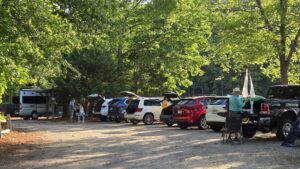 Like the others, I started unloading and getting my boat together, I visited my local buddies and some familiar visiting competitors from past regattas. I also chatted with many new folks I had met at the fantastic BBQ dinner the night before. There was a pretty energetic wind pumping across the lake and discussion of B-rigs was a hot topic, as it was not a matter of if, but when. The second most popular topic was the possibility of rain on Sunday. Everyone knows the purchase of a sailboat makes you an instant meteorological mastermind!
Like the others, I started unloading and getting my boat together, I visited my local buddies and some familiar visiting competitors from past regattas. I also chatted with many new folks I had met at the fantastic BBQ dinner the night before. There was a pretty energetic wind pumping across the lake and discussion of B-rigs was a hot topic, as it was not a matter of if, but when. The second most popular topic was the possibility of rain on Sunday. Everyone knows the purchase of a sailboat makes you an instant meteorological mastermind!
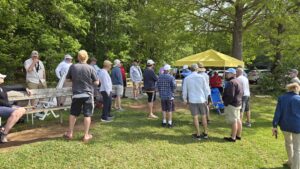
The hail of “SKIPPER’S MEETING!” rang out and we gathered around our PRO Martin Bowers to get our marching orders for the day. There was a lot to absorb for the new folks that may not have sailed under a promotion/relegation scoring system and Steve Landeau helped clarify details on how the two fleets would operate. Martin explained the course, answered questions, and sent us off to start final preparations for the day’s racing.
The morning’s racing that followed was mildly controlled chaos depending on your choice of rig and a bit of luck. The cycle of wind was just long enough to give you confidence it was going to calm down or never stop blowing, so there were some unexpected surprises for many folks as early races were a mix of overpowered A-rigs or B-rigs wishing for more wind. Feeling great about your A-rig choice at the two-minute mark turned to dread as you watched the lake turn dark with strong winds that should hit the start line at the same time as your boat!
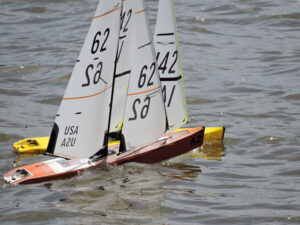
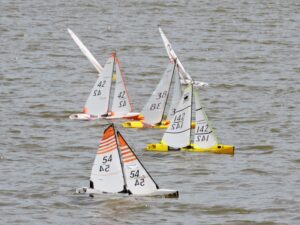
As we approached mid-morning into lunch, B-rigs were definitely in the majority as the winds increased. The weather was expected to hold strong after lunch, but it began to lighten and the A-rigs returned and we went from gusty to shifty. Our windward marks may need a wash down with holy water after all the curses heaped on them Saturday. South veering winds spilling over the distant tree line were turning hopes into headers all afternoon.
By the end of the day the scores showed the power of experience, as the top 3 were in their own league. Many down below in A fleet could not muster the consistency needed to break away and the point spread was very narrow between them. There were a few poor souls that rode the bubble all day, passing from one fleet to the other, never getting a chance to catch their breath. More than a few B fleet guys were happy just to pull out intact boats as they crossed the finish line for the last time that day. It had not been an easy day on the water, but at least it was never dull!
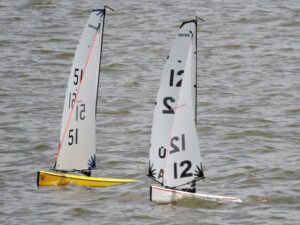
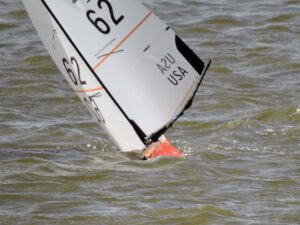
The answer to the question of Sunday’s weather loomed ahead and forecasts were of little help, except to show we should bring a raincoat and expect to wear it at some point. If half the fleet prays for unpredictable conditions to shake up the rankings and half prays for calm weather to keep them steady, who would prevail? I am sure no one was watching the skies than Martin. He had pushed us hard Saturday, just in case the worst happened and sailing had to be abandoned due to heavy weather Sunday.
Sunday morning’s arrival had a different feel than before. The strange sights from the day before were now familiar. Those new sail numbers seen yesterday on the water were easily identified and I knew at a glance who was warming up for the day. Today at the water’s edge, the accents of French-Canadian, New Zealand, Barbados, UK, Yankees, and East Carolina redneck meant friends, not foreigners. The energy was a bit dampened from the day before, but the positive vibe was still there. There was some light rain coming and going, but thankfully no thunder and lightning, which would have stopped the racing. The wind had not arrived when we showed up, but just as the appointed time approached, you could see a boat out to windward picking up steam. Could it be heeling? You could see the grins appearing as soon as each skipper felt the breeze themselves. It may be wet, but at least the boats will be moving!
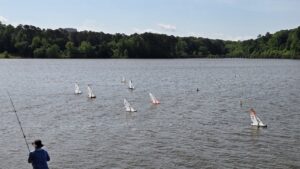 I’m going to catch me a big one !!
I’m going to catch me a big one !!
Martin was eager to get us going in case conditions deteriorated, so the skipper’s meeting was brief. Everyone not sailing was
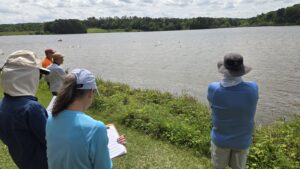
watching the first race to get hints and ideas on what was going to work in light air. So it went, proceeding with caution around the course as the breeze started to build and rains came and went in the counterpoint rhythm to your decision to remove your transmitter cover or rain gear. It was good to see that there was a glow of sunshine in the distance, but would it make it to us? It was becoming a case of “shiver me timbers” indeed, as the wet sucked away your core heat, the building breeze accelerated it, and the hiding sun provided no warmth to recharge. I found myself standing in the creek for extended periods when launching and retrieving my boat simply because the water was warmer than me.
About mid-morning, it seemed as the rain was finished toying with us, only to be replaced with shifts. The course began needing frequent adjustments and finding a reliable groove to follow was a challenge. I am not sure when I last sailed a direct out and back course at TMYC, as it doesn’t happen often. The swings were getting wide and the course had to be set to completely different banks of marks to windward at times, not just shifting up or down a single mark.
For a short time, Martin had to whistle for races to be abandoned because the first windward mark could be reached without tacking. Personally, I managed one of the best starts of my life, sailing up the course windward of the entire fleet, and crossing the upwind mark with a head of steam and a bit of a lead to work with. Unfortunately, I had not touched my rudder once! It had been a fairly quiet morning on the course, because it takes more focus to get around in the light air. For the first time, there was some good-natured laughter and joking on the water about the conditions. Martin had to follow the rules to maintain a fair race course, but around the third time this had happened, you hear folks going *COUGH* Tack! *COUGH* and more laughter.
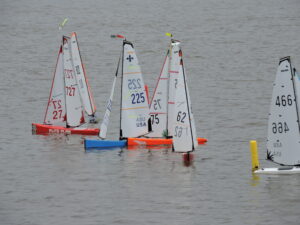
A regatta is also a battle of attrition and fatigue as physical and mental issues arise over the long sailing days. Saturday it was mostly wind-related damage and Sunday there were multiple issues with wet radios in the morning and dead batteries in the final race. Technical issues were causing some unplanned shifts in the final standings. Also, the mental and physical fatigue of travel and racing started to kick in Sunday and some skippers were fading as we headed towards our 2:00 finish time. Protests were becoming a bit more vigorous as folks were making rushed decisions and finding themselves in bad places. Many of those decisions affected the racing of others and resulted in marks being missed or boats being hooked tight to them. The windward mark was getting plenty of revenge for all the abuse heaped upon it the day before! Even being a few feet from the finish line was no sure thing, as victims of hubris or wind shifts sat still in irons with the finish line just out of reach, watching points slip away as others sailed past.
The only folks seemingly unaffected by the drama on the course were the pack leaders. Tony, Steve, and Gary held an unassailable lead, only all
owing 2 other folks to squeeze in a fortunate win all weekend. There was a huge amount of experience stacked up at the top of the rankings and these guys owned the regatta from start to finish while the rest of us fought tooth
and nail for the leftovers. At the same time, they were still available for help with questions from any one that asked and volunteered advice and help when they saw the need.
—
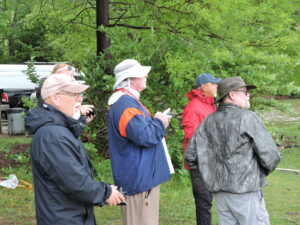
I have to step backwards in my tale for a minute, because I can give no better example than my own experience Saturday morning. Minutes before racing started, when they should have been attending their own boats and without needing to be asked, Tony and Steve were on their hands and knees saving me from my own idiocy as the 3 of us were frantically drawing numbers on my new B-rig sails that I had set up, but completely forgotten to write my sail numbers on! There aren’t many that would have done the same and to have the strongest contenders at the regatta pulling my butt out of the fire was the most powerful example of Corinthian spirit I have seen. I ran for the start line and after barely getting my boat in the water on time, looked back to see Tony on his knees still scratching away at my sails. It was strange to feel ashamed and also blessed by an act of random kindness at the same time.
Now, I have to stack that favor up alongside the other kindnesses and advice those two have offered me at the regattas we have attended together. A “Thank You!” can never pay it back to equal effect, only by paying it forward can I hope to satisfy that kind of debt. When I was at my lowest, they were at their best. Those fellas have permission to give me a hard time about this for as long as we sail together and are allowed to damage my charge card mercilessly the next time we walk into a bar!
—
As the last races passed, folks made their best, last-ditch efforts to reach upward or shed those nipping at their heels. Whether you viewed it as a chance to earn a few crucial points or one last chance to snatch defeat from the jaws of victory, we all made our last stands. No matter how much fun or frustration you have had, there is always a small relief to cross the finish line one last time. Despite being cooked in the sun and tossed around by wind and waves, your boat, brain, and body have survived. You may even be showing off that broad patch of spinnaker tape across your holed hull, as proud evidence of the battles you survived.

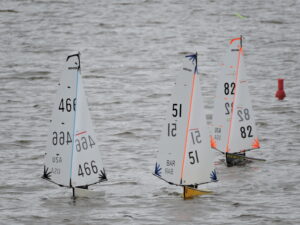
Finally, a bit weathered and weary, we gathered around Martin once more for an informal closing ceremony. I don’t think there is much surprise about the first three positions by now, or how the rest of us did, since the scores were posted yesterday. Tony had bested all of us, winning the Championship for the 2nd year in a row. He gave a short and gracious acceptance speech of thanks to well-deserved applause.
We also thanked Martin for his service as PRO. Martin competed last year, but bowed out and stepped up as PRO in order to make our regatta happen this year. He kept us sailing and ran a very fair regatta with a grasp neither too tight or loose, applied as needed. I don’t think many can fully appreciate the amount of work he put in for weeks, even months before the regatta. Martin has been a fantastic addition to TMYC and has helped push our entire club to new heights.
In Martin’s closing remarks, he acknowledged all those that supported his efforts to help us to have so much fun. He was smart enough to put together a steadfast team of scorekeepers made up from the wives of participants. You would think it would be hard enough to keep one fella in line, but keeping 20+ of us managed is a feat that only took a few sharp women to manage!
He also thanked TMYC members who had helped behind the scenes. Martin also had some very nice words for the staff of Lake Crabtree Park. Drew Cade and his team have been very supportive of TMYC and they understand that we are more than just a few guys showing up for Saturday fun. Over time, we have become a feature of the park, attracting visitors that come just to watch the sailboats passing quietly across Lake Crabtree. Both organizations are stronger for the support and respect we give each other.
At last, the time had come to not say “Goodbye”, but “See you next year!’ to our visiting skippers. Handshakes and fist bumps passed all around. TMYC members were already making plans for next Saturday’s racing. Cars were packed. Tents were folded. Marks retrieved or reset. The scoring table was cleared of layers of items in search of a flat spot to rest. As the last car pulled away, the site was left clean and empty as we found it with no trace of the weekend’s activity except footprints. A clean slate, full of promise for the next event.
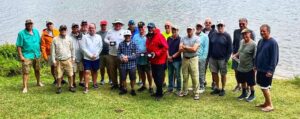
Lake Crabtree quietly awaits our return.
Thanks folks,
Will Newton
DF95 #142
2025 DF95 Region 1 – Regional Regatta Report
On Saturday and Sunday April 26 & 27 the second annual Region 1 Championship was held at Sail Newport on Fort Adams in Newport Rhode Island. Hosted by the Newport Model Sailing Club, 40 sailors participated in extremely challenging conditions.
The Friday afternoon practice session was held in 10 to 15 knot SSW winds and a partly cloudy sky. This was the calm before the storm!
Saturday dawned with ominous gray skies and 15-18 knot winds with gusts over 20 knots… then it got really gnarly! By the end of the skippers meeting, we had 17-22 knot winds and torrential rains. Full foulies required! Throughout the morning the preferred sail choice was the B Rig, and there were several transmitter failures due to the driving rain. By early afternoon the rain abated, and the winds died down to A Rig range for the rest of the day.
The real heroes of the day were the RC team that braved the elements all day to run 6 full races!
At the end of the race day, it was time to peel off the foul weather gear, cleanup the boats, and recount the good, the bad, and the ugly of the day over beers and dogs. Great conversations and great fun!
On Sunday the rain subsided, but we had shifty WNW winds. The wind speeds and direction varied all day requiring 3 major course changes and requiring multiple rig changes depending on the heat you were in. Some competitors changed rigs 4 times throughout the day as wind speeds varied between upper A Rig to mid B Rig. Throughout the day temps warmed, and it turned into an absolutely beautiful sailing day.
The fleet was made up of a good mix of local and regional sailors and several of the DF95 road warriors. In the end the top 5 places reflected that mix of sailors. Fifth place went to Tony Gonsalves; fourth place went to Brad Read; third place went to Steve Landau; second place went to Peter Feldman; and first place went to a relatively unknow sailor by the name of Ken Read!
Henry DiPietro
2025 DF95 Region 1 Championship Complete Results
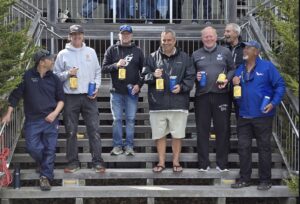
DF95 Region 8 Travel Trophy Estrella North Lake, Goodyear, Arizona.
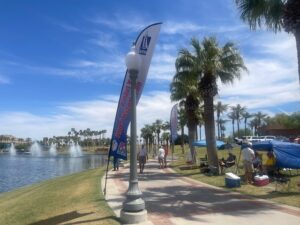
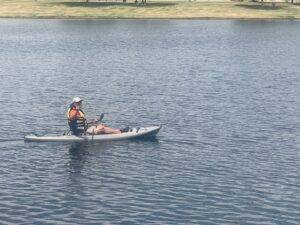
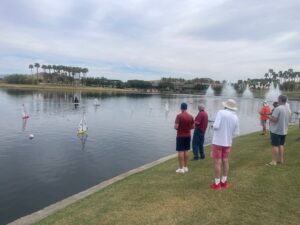
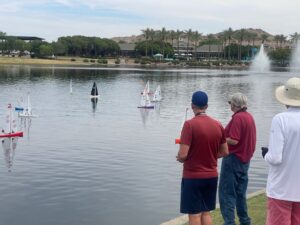
2025 Dallas Blowout, DF95 R5CR
Written by: Len Bose
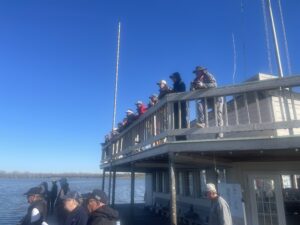
Saturday, March 15, 2025, White Rock Lake Dalles Texas, Corinthian Sailing Club DF 95 “Dalles Blowout”.
Friday’s Practice and check-ins were just that a “Blowout” with a breeze between 17-23 knots with puffs touching 30 knots with HUGE waves. I spent my time putting my boat and A rigs together then headed outside the clubhouse. With ten boats on the water under C rigs rounding the weather mark. I sat down quickly flashing back to the 2013 America Cup in San Francisco when I first witnessed a 72’ catamaran get up on its foils. “OH SHIT look at that thing go,” I said laughing in a humbled tone. I was missing a part of my C rig which kept me from placing my boat in the water, or that’s what I was telling everyone that was asking me why I had not jumped in.
Two years ago I attended the blowout with my write-up referring to Chuck LeMahieu as ”Chuckles” the father of a gal I was dating and meeting for the first time, I also referred to meeting “Mr. Texas” Brig North and mentioned meeting Tony Gonzales for the first time, of course, the true gem of the family Carry “CJ” LeMahieu who always greets you with the warmest greeting that makes you feel right at home. This year walking into the Corinthian Sailing Club it felt more like returning home for the holidays and visiting the family. All my favorite relatives were there Chuckles, North, Gonzalves, Steve Landau, Dan Shier, Chris Collins, Russ Gardner, Joe Ruddy, Jon & Dennis Rogers, Jim Sears, James Stinson and a couple of relatives you hope don’t drink too much over dinner. I say that jokingly because I am normally that relative who finishes off the bourbon bottle. Speaking of dinner, Chuckles serves up one hell of a Texas BBQ, this year was Bratwurst boiled with a favorite brew of Chuck’s then grilled to perfection along with the tastiest Pork Chops I ever have had off the BBQ. Now blend in a couple of beers and the HUGE rum squall that came overhead of the club made for another memorable evening. Now I did happen to notice that “Rum Squalls” tend to form in the proximity of Gonzales. So there we were Gonzales, Sears and I with this huge squall approaching while I was trying to explain that it would be best to gybe onto port and exit the squall with the spinnaker pole on the port side. This will keep you in the squall longer and not fall into the back side of this squall, which is slow. Gybe back and forth in front of the squall for as long as you can. The gybes went perfectly and we did not round up or down when we exited the clubhouse that night.
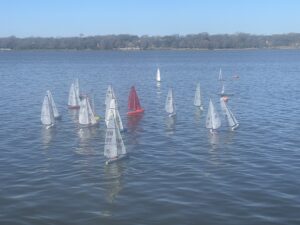
Saturday racing was all about “Valor and Swagger” “Valor” refers to boldness or determination in facing danger, especially in battle, while “swagger” describes a confident, often arrogant, or boastful manner. The breeze was well into the 30 knots plus range and at the top end of the C rig, one cannot take their eye off the boat for a second. The boats appeared to be flying fish jumping out the the water. My sunglasses were continually blowing off my face, and after four races in the top of C rig conditions, I just could not find my mojo while making novice mistakes. The term novice is not in the playbook of competitors Landeau, Barr Batzer, and Brian Shores. Their valor was on their faces climbing a hilltop of stairs to get to the preferred ground of the yacht club’s roof. Their swagger was to keep their awareness in these challenging conditions. To me, it was rather obvious how the South had come close to winning the Civil War.
That night Sears and I joined Landau and Gonsalves for dinner, and these get-togethers are almost as fun as sailing DF 95’s in 35+ knots. All the sailor’s stories come out on the table while there are always a couple of real “Whompers” that kick the fun meter into the red. The evening was almost a round down, somehow, we kept the mast dry and broke the fun meter for the perfect day with the Texas Blowout family. While in Texas one must remember “Not to squat on your spurs”
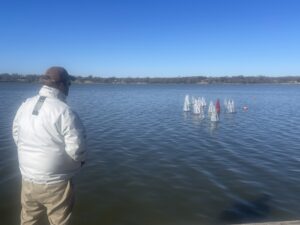
Sunday was a bit of a struggle to come on watch and wrap this gathering up, deep breathing and lots of water got us to the starting line. Sears and I shared a rental car and only used hand signals to the clubhouse. Sears sailed well this weekend finishing in sixth while I still struggling to meet my goals of finishing in the top half of the fleet, and Dan Shier beat me again. Shier and I have an ongoing rivalry, and I am sure neither of us would care if we finished second to last as long as we finished in front of the other. You will get a better review of the weekend by watching Shier’s video (SEE BELOW) he took tune into Olympia Model Sailing on YouTube.
Sunday sailing was a light breeze between 3-7 knots with long courses, as forecasted the breeze diminished as we approached high noon, and we only got in four more heats before calling it a regatta. I am much more comfortable sailing in lighter breezes coming from Southern California and let’s just say “I will go to Texas”.
Huge shout out to CJ and Chuck LeMahieu. After Saturday’s racing “Chuckles” asked, “Who does not like sailing in 30+ knots or wind with huge surf then having cocktails with the DF95 family?”. I would also like to shout out to James Stinson for coming up to me saying hello and telling me he likes my stories.
I plan on making the “Blowout” an annual event on my calendar because life is too short not to take part in a good “Blowout”
Let’s go sailing!
The Winners Circle: (photos by W. Ramlo)
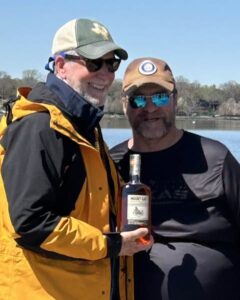
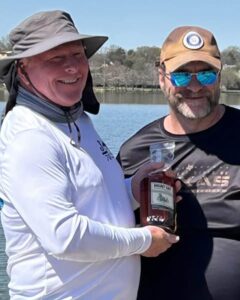
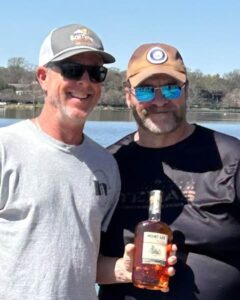
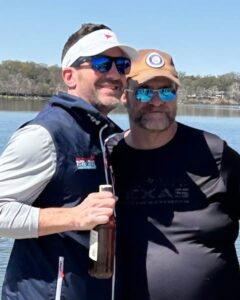

Videos:
Jess Atkinson Interview
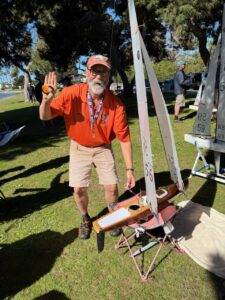
DF 95 Traveler Series Interview number 2.
February 25th, 2025.
Jess Atkinson, winner of the Midwinter/ Traveler Regatta at
Eldorado Park. ( second venue in Traveler Series).
BY: Eugene Elliott M.D.
Question;
Jess, you are well-known on the West Coast and beyond for your RC sailing
Expertise. Tell me a little bit about your life journey.
Jess;
For the last 42 years, I drove tugboats, both coastal and harbor. I was in San Francisco
Bay for over 30 years and was in Southern California for about six years prior to moving.
North.
I learned to sail as a young kid on the lakes in Arizona. My Dad started me out there.
Question;
What kind of boats?
Jess;
My Dad built our first sailboat. It was an inland lake planning skow. Then I had a boat called an
Eightball which was similar to a Naples Sabot.
Question;
As an adult working in the maritime industry did you have time to sail?
Jess;
I did some sailing. I owned a 30-foot sailboat, and sailed to Catalina often. That’s how
I dated my future wife. When we moved to Northern California I bought a 48-footer.
We lived on that boat in Alameda.
Question;
How and when did you get interested in RC sailing?
Jess;
I got exposed to RC sailing when I was really young, maybe 13 or 14y.o., before I could drive a car. My uncle was doing it. He would bring us down to the Mission Bay pond in San Diego.
Many times. When I was in high school I built a 36/600. Never got to float it. My brother was involved in radio boats. I was always a hobbyist. I flew gliders for a while. I really started
Sailing RC sailboats when my uncle became too old, he gave his fleet to my brother and me.
Question;
When did RC sailing become a serious endeavor?
Jess;
I was given a Soling 50 in about 1993-4. I sailed it one day a month but wanted to
Be more active so I bought an Odom kit, and actually built a couple of them. I would come
Down to King Harbor and race. My brother had a Santa Barbara so I bought a Santa.
Barbara. When I came down to visit my brother on the weekends we would race both classes. That kickstarted the progression of RC sailing.
Question;
Eldorado Pond, two weeks ago, no wind, no patterns, you were pretty much unbeatable,
Not by short distances, just plain dominant, connecting all the dots that no one else could
See. What are your thought processes in very light air?
Jess;
First and foremost I keep the boat moving. The wind and my tune were at one with each other. I was just along for the ride and my boat took me there. I just let it rip.
I set the boat up a little loose. You can’t have the boat set up for 6 knots of wind if you’re
Sailing in one knot.
Question;
I observed you were working the sails a lot. Is that something you consciously think about?
Jess;
I think about working the sails more than the rudder. From RCs to dinghies to big boats
Staying off the rudder is faster.
Question;
So when you got a lift, you didn’t necessarily take it?
Jess;
I would initially sheet out a little bit which would generate some speed which helps to generate some flow then I would sheet in if I needed to depending on the lay lines.
Question;
Do you use that technique in all conditions or more prevalently in light air?
Jess;
When the conditions and situations dictate I do like that technique but there are times.
When sailing a tighter weather course is also important.
Question;
When you say loosen the boat for light air, you’re mostly referring to twist/
Jess;
correct
Question; I’ve read that light air tuning is not too dissimilar to heavy air tuning in the sense
In heavy air you want more twist to depower the boat. Is that accurate?
Jess;
The concept is good but it’s not the same. The day before Eldorado I raced in San Diego in
4-6 knots and the biggest change I made in my tune was to let off the vang a little bit in
Eldorado.
Question;
Recently at Mission Bay Aquanauts, you gave a really good seminar on tuning the DF 95.
In that seminar, you explained looking at the break of the jib and adjusting the twist.
To basically have an even break from top to bottom. Can you, for the benefit of our
The audience explains that concept.
Jess;
It’s a sailing and tuning technique I use. From making my own sails I have learned what
Makes a boat go fast and slow. I learned that most of it had to do with how much twist was
In the jib. So then I figured out not just with measurement but how to read it on the water.
So I could pull the boat in quickly and make changes as necessary between races.
I developed an eye for that. I generally let the top of the sail lead in the break, then the break moves down instead of letting the bottom of the sail lead the break. It’s a visual
Concept.
Question;
So if the bottom of the sail was breaking first you would add a little more twist?
Jess;
That’s correct. If I’m sailing and the top is just stalling and flogging I would tighten up the
Leach. It’s the same concept as moving the car on a big boat. The topping lift is the solution for that in radio sailing boats. I’m an advocate of tuning my boat on the water. You might
Bring it back once or twice or four times. I don’t do it all on the beach and just go sailing.
Question;
I was told you set the twist of the main and then match the jib twist to the main.
Jess;
I don’t think it’s a bad idea, but sometimes I see guys set up their DF95 with too flat a main
Verses IOMs that tolerate a tighter leach. If you then match a tight main leach to the jib you’ll have a case of the slows.
Question;
How did you get interested in sailmaking?
Jess;
I had a dear friend, rest in peace named Karl Tulp.. He was making sails for guys.
I asked him to make some sails for me. I used his sails for a long time. I got 4th in the
Odom Nationals of 2002 in Las Vagas with his sails. After that, he told me he was not going.
To make any more sails for me but he would teach me how, using the Swede Johnson.
Technique. I’ve expanded on that but still use his 101 principles. The art of being able to create drove the whole sail-making thing. I owe my appreciation to Carl who got me started.
Question;
I would think that being an accomplished sailmaker gives you a heightened understanding of what makes a boat go fast.
Jess;
I think it does in the sense that I’m very conscious of the work that I do.
Question;
What’s your basic routine between races?
Jess;
I’ll take a look up and down the pond and adjust my boat accordingly but I still will
Take a new look sailing for final adjustments.
Question;
Are any pearls in your basic boat preparation?
Jess;
I go through the boat in my garage, but if it isn’t broken I don’t fix it, but if I see a chaffed line I will change it. If any of these boats are tuned properly they are on fire, so not a lot of changes, just millimeters if necessary.
Question;
I don’t know if you’re planning but if you were going to sail in the DF95 NCR in Newport Rhode Island, current, likely waves. What is your technique for getting a low-inertia boat
Through the waves?
Jess;
That’s a really good question. I revert back to some of my big boat stuff. Mostly I try not to get stalled out on the crest of the wave. The tune is completely different and it’s all about making sure the boat doesn’t lose power. Your situational awareness has to be heightened.
When and when not to tack You have to think ahead. If you tack at the wrong time you could end up stopped dead by the crest of a wave in irons.
Question;
Your concept of situational awareness is really important.
Jess;
I think a lot of radio sailors are focused on their boats and possibly on the body of water. But
Then you have the guys that are looking windward, looking at the puffs, lifts, headers.
Those are different levels of situational awareness. Putting all those pieces together is when you start winning. That’s when you see guys rise to the top like Gary Boell, Sean Fidler, Peter Feldman, Steve Landeau, and Craig Mackey to name only a few.
For me, not to be redundant, I think it’s all about situational awareness.
Question;
What else can you say about the radio sailing sport?
Jess;
I am passionate about running clinics and teaching in my local pond, San Diego.
Argonauts. I have recently run clinics for the DF95, IOM, and coming up the Odom.
I’m really happy to be part of what the San Diego Argonauts are doing right now.
Through the clinics and other events, radio sailing is being promoted and the bar is
Lifted for everyone.
Question;
When I go sailing in San Diego I notice you will approach a sailor in a constructive fashion.
And offer a little tuning or tactical suggestion. I wish there were Jess’s at all radio.
Sailing clubs raising the bar.
Jess;
I relocated to San Diego 2 years ago but raced in 1998 in Soling 50’s.at Race Week.
I have noticed when I started sailing in San Diego 2years ago there was a lot of separation.
Between the top and bottom. Not so much anymore. That’s good for our sport and that’s
What I feel good about.
Question;
This has been great Jess. Do you have any questions?
Jess;
No, but I would like to end this with a quote from Paul Elvstrom;
I heard him once say when asked how to make a boat go fast his response was;
“I sit on the weather rail and stare blindly into the horizon”
Eugene Elliott MD is an active RC sailor and member of the OCMSC and The San Diego Argonauts. Sailing DF 95’s, IOM’s, and Volvo 70’s”
